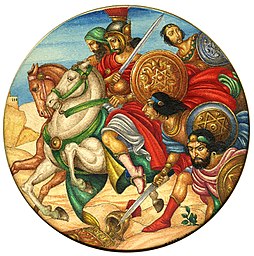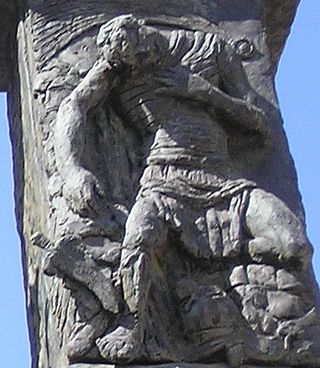Loading AI tools
Leader of the Bar Kokhba revolt (132–136 CE) From Wikipedia, the free encyclopedia
Simon bar Kokhba (Hebrew: שִׁמְעוֹן בַּר כּוֹכְבָא Šīm‘ōn bar Kōḵḇāʾ) or Simon bar Koseba (שִׁמְעוֹן בַּר כֹסֵבָא Šīm‘ōn bar Ḵōsēḇaʾ), commonly referred to simply as Bar Kokhba,[a] was a Jewish military leader in Judea. He lent his name to the Bar Kokhba revolt, which he initiated against the Roman Empire in 132 CE. Though they were ultimately unsuccessful, Bar Kokhba and his rebels did manage to establish and maintain a Jewish state for about three years after beginning the rebellion. Bar Kokhba served as the state's leader, crowning himself as nasi (lit. 'prince').[3] Some of the rabbinic scholars in his time imagined him to be the long-expected Messiah of Judaism. In 135, Bar Kokhba was killed by Roman troops in the fortified town of Betar. The Judean rebels who remained after his death were all killed or enslaved within the next year, and their defeat was followed by a harsh crackdown on the Judean populace by the Roman emperor Hadrian.
| Simon bar Kokhba שִׁמְעוֹן בַּר כּוֹכְבָא | |
|---|---|
| Prince of Israel | |
 Watercolour and gouache impression of Bar Kokhba by Polish-Jewish artist Arthur Szyk (1927) | |
| Reign | 132–135[1] |
| Born | Simon bar Koseba (שִׁמְעוֹן בַּר כֹסֵבָא)[2] |
| Died | 135 Betar, Judea, Roman Empire |
| Religion | Judaism |
| Occupation | Military leader |
Documents discovered in the 20th century in the Cave of Letters give his original name, with variations: Simeon bar Kosevah (שמעון בר כוסבה), Bar Kosevaʾ (בר כוסבא) or Ben Kosevaʾ (בן כוסבא).[4] It is probable that his original name was Bar Koseba.[5] The name may indicate that his father or his place of origin was named Koseva(h), with Khirbet Kuwayzibah being a likely nominee for identification;[6][7][8] Others, namely Emil Schürer, think the surname may have been an indication of his place of birth, in the village known as Chozeba (maybe Chezib)[9] but might as well be a general family name.[5]
During the revolt, the Jewish sage Rabbi Akiva regarded Simon as the Jewish messiah; the Talmud records his statement that the Star Prophecy verse from Numbers 24:17:[10] "There shall come a star out of Jacob,"[11] referred to him, based on identification of the Hebrew word for star, kokhav, and his name, bar Kozeva. The name Bar Kokhba, which references this statement of Akiva, does not appear in the Talmud, but only in ecclesiastical sources, until the 16th century.[12] The Jerusalem Talmud (Taanit 4:5) and the Babylonian Talmud (Sanhedrin 93b and 97b) mention him by the name of Bar Kozeva.



Despite the devastation wrought by the Romans during the First Jewish–Roman War (66–73 CE), which left the population and countryside in ruins, a series of laws passed by Roman Emperors provided the incentive for the second rebellion.[14] Based on the delineation of years in Eusebius' Chronicon (whose Latin translation is known as the Chronicle of Jerome) the Jewish revolt began under the Roman governor Tineius (Tynius) Rufus in the 16th year of Hadrian's reign, or what was equivalent to the 4th year of the 227th Olympiad. Hadrian sent an army to crush the resistance, but it faced a strong opponent, since Bar Kokhba, as the recognised leader of Israel, punished any Jew who refused to join his ranks.[15] Two and a half years later, after the war had ended, the Roman emperor Hadrian barred Jews from entering Aelia Capitolina, the pagan city he had built on the ruins of Jewish Jerusalem. The name Aelia was derived from one of the emperor's names, Aelius.[16] According to Philostorgius, this was done so that its former Jewish inhabitants "might not find in the name of the city a pretext for claiming it as their country."[16]
For many Jews of the time, this turn of events was heralded as the long hoped for Messianic Age. The Romans fared very poorly during the initial revolt facing a unified Jewish force, in contrast to the First Jewish–Roman War, where Flavius Josephus records three separate Jewish armies fighting each other for control of the Temple Mount during the three weeks after the Romans had breached Jerusalem's walls and were fighting their way to the center.[citation needed] Being outnumbered and taking heavy casualties, the Romans adopted a scorched earth policy which reduced and demoralised the Judean populace, slowly grinding away at the will of the Judeans to sustain the war.[citation needed]
During the final phase of the war, Bar Kokhba took up refuge in the fortress of Betar.[citation needed] The Romans eventually captured it after laying siege to the city.[citation needed]
The Jerusalem Talmud makes several claims considered as non-historical by modern scholarship. One such claim is that the duration of the siege was of three and half years, although the war itself lasted, according to the same author, two and half years.[b] Another part of the Talmudic narrative is that the Romans killed all the defenders except for one Jewish youth, Simeon ben Gamliel II, whose life was spared.[18] According to Cassius Dio, 580,000 Jews were killed in overall war operations across the country, and some 50 fortified towns and 985 villages razed to the ground, while the number of those who perished by famine, disease and fire was beyond finding out.[19]
So costly was the Roman victory, that the Emperor Hadrian, when reporting to the Roman Senate, did not see fit to begin with the customary greeting "If you and your children are healthy, it is well; I and the legions are healthy."[20][21]
In the aftermath of the war, Hadrian consolidated the older political units of Judaea, Galilee and Samaria into the new province of Syria Palaestina, which is commonly interpreted as an attempt to complete the disassociation with Judaea.[22][23][24]
In the late 20th and 21st century, new information about the revolt has come to light, from the discovery of several collections of letters, some possibly by Bar Kokhba himself, in the Cave of Letters overlooking the Dead Sea.[25][26] These letters can now be seen at the Israel Museum.[27]
In March 2024, a coin bearing the inscription "Eleazar the Priest" was found along with "Year 1 of the Redemption of Israel" on the bottom.[28]
According to Israeli archaeologist Yigael Yadin, Bar Kokhba tried to revive Hebrew and make Hebrew the official language of the Jews as part of his messianic ideology. In A Roadmap to the Heavens: An Anthropological Study of Hegemony among Priests, Sages, and Laymen (Judaism and Jewish Life) by Sigalit Ben-Zion (page 155), Yadin remarked: "it seems that this change came as a result of the order that was given by Bar Kokhba, who wanted to revive the Hebrew language and make it the official language of the state."
"From Shimʻon ben Cosibah to Yeshuʻa ben Galgulah and to the men of the Gader, Peace. I call heaven to my witness that I am fed-up with the Galileans that be with you, every man! [And] that I am resolved to put fetters on your feet, just as I did to Ben ʻAflul."
(Original Hebrew)
משמעון בן כוסבה לישע בן ג[ל]גלה ולאנשי הכרך[c] שלו[ם]. מעיד אני עלי ת שמים יפס[ד][d] מן הגללאים שהצלכם[e] כל אדם שאני נתן תכבלים[f] ברגלכם כמה שעסת[י] לבן עפלול [ש]מעון ב[ן][g]
Simon bar Kokhba is portrayed in rabbinic literature as being somewhat irrational and irascible in conduct. The Talmud[30] says that he presided over an army of Jewish insurgents numbering some 200,000, but had compelled its young recruits to prove their valor by each man chopping off one of his own fingers. The Sages of Israel complained to him why he marred the people of Israel with such blemishes. Whenever he would go forth into battle, he was reported as saying: "O Master of the universe, there is no need for you to assist us [against our enemies], but do not embarrass us either!"[30] It is also said of him that he killed his maternal uncle, Rabbi Elazar Hamudaʻi, after suspecting him of collaborating with the enemy, thereby forfeiting Divine protection, which led to the destruction of Betar in which Bar Kokhba himself also perished.[30]
Hadrian is thought to have personally supervised the closing military operations in the siege against Betar. When the Roman army eventually took the city, soldiers carried Bar Kokhba's severed head to Hadrian, and when Hadrian asked who it was that killed him, a Samaritan replied that he had killed him. When Hadrian requested that they bring the severed head (Greek: protome) of the slain victim close to him that he might see it, Hadrian observed that a serpent was wrapped around the head. Hadrian then replied: "Had it not been for God who killed him, who would have been able to kill him!?"[31]
Bar Kokhba was a ruthless leader, punishing any Jew who refused to join his ranks. According to Eusebius' Chronicon, he severely punished the Christians with death by different means of torture for their refusal to fight against the Romans.[15]


Since the end of the nineteenth century, Bar-Kochba has been the subject of numerous works of art (dramas, operas, novels, etc.),[32] including:
Another operetta on the subject of Bar Kokhba was written by the Russian-Jewish emigre composer Yaacov Bilansky Levanon in Palestine in the 1920s.
John Zorn's Masada Chamber Ensemble recorded an album called Bar Kokhba, showing a photograph of the Letter of Bar Kokhba to Yeshua, son of Galgola on the cover.
According to a legend, during his reign, Bar Kokhba was once presented a mutilated man, who had his tongue ripped out and hands cut off. Unable to talk or write, the victim was incapable of telling who his attackers were. Thus, Bar Kokhba decided to ask simple questions to which the dying man was able to nod or shake his head with his last movements; the murderers were consequently apprehended.
In Hungary, this legend spawned the "Bar Kokhba game", in which one of two players comes up with a word or object, while the other must figure it out by asking questions only to be answered with "yes" or "no". The questioner usually asks first if it is a living being, if not, if it is an object, if not, it is surely an abstraction. The verb kibarkochbázni ("to Bar Kochba out") became a common language verb meaning "retrieving information in an extremely tedious way".[34]
Seamless Wikipedia browsing. On steroids.
Every time you click a link to Wikipedia, Wiktionary or Wikiquote in your browser's search results, it will show the modern Wikiwand interface.
Wikiwand extension is a five stars, simple, with minimum permission required to keep your browsing private, safe and transparent.